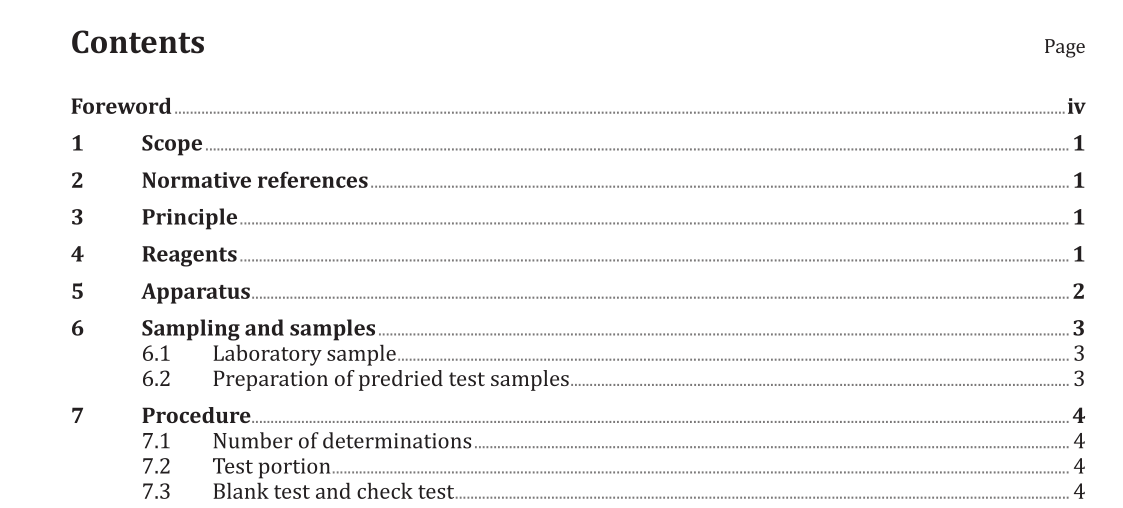ISO 15634:2015 pdf download.Iron ores — Determination of chromium content — Flame atomic absorption spectrometric method
1 Scope
This International Standard specifies a flame atomic absorption spectrometric method for the determination of the chromium content of iron ores.
This method is applicable to chromium contents between 0,001 6 % and 0,1 % (mass fractions) in natural iron ores, iron ore concentrates, and agglomerates including sinter products.
2 Normative references
The following documents, in whole or in part, are normatively referenced in this document and are indispensable for its application. For dated references, only the edition cited applies. For undated references, the latest edition of the referenced document (including any amendments) applies.
ISO 648, Laboratory glassware — Single-volume pipettes
ISO 1042, Laboratory glassware — One-mark volumetric flasks
ISO 3082, Iron ores — Sampling and sample preparation procedures
ISO 3696, Water for analytical laboratory use — Specification and test methods
ISO 7764, Iron ores — Preparation of predried test samples for chemical analysis
3 Principle
The test portion is decomposed by treatment with hydrochloric and nitric acids.
The major portion of iron in the filtrate is removed by extraction with 4-methylpentan-2-one.
The insoluble residue is ignited and the silicon dioxide is removed by evaporation with hydrofluoric and sulfuric acids. The residue is fused with a mixture of sodium carbonate and sodium tetraborate,and then dissolved with hydrochloric acid and combined with the main solution.
The solution is aspirated into the flame of an atomic absorption spectrometer using a nitrous oxide-acetylene burner.
The absorbance values obtained are compared with those obtained from the calibration solutions.
4 Reagents
During the analysis, use only reagents of recognized analytical grade.
4.1 Water, complying with grade 2 as defined in ISO 3696.
4.2 Sodium carbonate, (Na 2 CO 3 ), anhydrous powder.
4.3 Sodium tetraborate, (Na 2 B 4 O 7 ), anhydrous powder.
4.4 Lithium tetraborate, (Li 2 B 4 O 7 ), anhydrous powder.
4.5 Hydrochloric acid, ρ 1,16 g/ml to 1,19 g/ml.
4.6 Hydrochloric acid, ρ 1,16 g/ml to 1,19 g/ml, diluted 2 + 1.
4.7 Hydrochloric acid, ρ 1,16 g/ml to 1,19 g/ml, diluted 1 + 1.
4.8 Hydrochloric acid, ρ 1,16 g/ml to 1,19 g/ml, diluted 2 + 100.
4.9 Nitric acid, ρ 1,4 g/ml.
4.10 Nitric acid, ρ 1,4 g/ml, diluted 1 + 1.
4.11?Hydrofluoric?acid, ρ 1,13 g/ml, 40 % (mass fraction) or ρ 1,19 g/ml, 48 % (mass fraction).
4.12 Sulfuric acid, ρ 1,84 g/ml.
4.13 Sulfuric acid, ρ 1,84 g/ml, diluted 1 + 1.
4.14 Methylpentan-2-one, (methyl isobutyl ketone, MIBK).
4.15 Chromium standard solution A, 100 µg Cr/ml.
Dissolve 0,100 0 g of chromium metal [purity >99,9 % (mass fraction) (see Note of 4.16)] in 20 ml of hydrochloric acid (4.7). After cooling, transfer to a 1 000 ml one-mark volumetric flask quantitatively, dilute to volume with water (4.1), and mix.
4.16 Chromium standard solution B, 10 µg Cr/ml.
Transfer 100,0 ml of chromium standard solution A (4.15) to a 1 000 ml one-mark volumetric flask. Dilute to volume with water and mix.
NOTE The purity of the metals stated on the certificates does not generally take into account the presence of adsorbed gases like oxygen, carbon monoxide, etc.
ISO 15634:2015 pdf download
